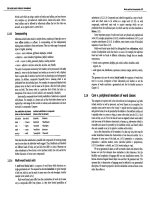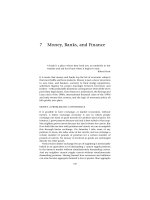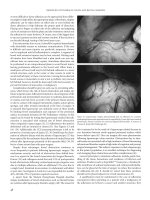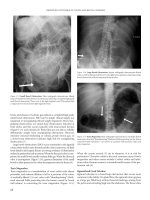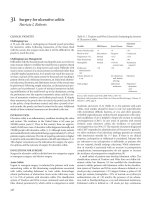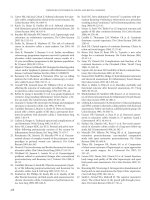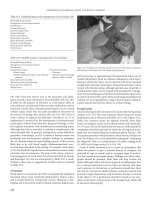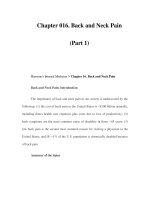Mobile Phones and Brain Tumours - part 7 ppsx
Bạn đang xem bản rút gọn của tài liệu. Xem và tải ngay bản đầy đủ của tài liệu tại đây (107.24 KB, 9 trang )
Mobile Phones and Brain Tumours © 2008, G. Khurana – All Rights Reserved.
www.brain-surgery.us
61
implored to make these technologies and their accessories decidedly safer and
then available to consumers.
o We are currently experiencing a relatively unchecked and dangerous situation
related to both "consumption at all costs" and "production at all costs".
o Worldwide availability and use of appropriately shielded cell phones and hands-
free devices including headsets, increased use of landlines and pagers instead of
current mobile and cell phones, and restricted use of cellular and cordless
phones among children and adults alike are likely to limit the effects of this
physically "invisible" danger.
o The author fears that unless the Industry and Governments take immediate and
decisive steps to openly acknowledge and intervene in this situation, even while
waiting definitive confirmation by large and well-constructed multi-centre studies
worldwide, malignant brain tumour incidence and its associated death rate will
be observed globally to rise within a decade from now, by which time it may be
far too late to meaningfully intervene, especially for those who are currently
children and young adults.
Mobile Phones and Brain Tumours © 2008, G. Khurana – All Rights Reserved.
www.brain-surgery.us
62
9. PRECAUTIONARY RECOMMENDATIONS:
The Precautionary Recommendations lays out in point form the evidence-based personal
health and safety guidelines recommended by the author regarding mobile phones.
For members of the General Public:
o Avoid directly exposing the "hearing system" and brain to electromagnetic
radiation by using a regular "landline" in preference to a hand-held mobile or
cordless phone;
o When requiring to use a mobile phone, increase the physical distance between
the device and the side of the head by using its "speaker phone" mode (with at
least 20 cm separation) or "in-vehicle hands-free" mode;
o Avoid converting the head into a mobile antenna by minimising the use of
current Bluetooth devices and unshielded wired-earphones for mobile phones;
o Minimise the time spent using mobile and cellular phones for all adults;
o Restrict the use of mobile and cellular phones by children to emergency
situations.
For members of the Telecommunications Industry:
o Expedite the research, development and promotion of safe and economical
shielding devices for mobile and cellular phones and their Bluetooth and headset
accessories - some of these are already available but currently poorly marketed;
o Further refine the quality of hands-free "speaker phone" mode.
For members of the Health and Scientific Communities:
o Objectively reanalyse all previous large-scale population studies that reported
"no link between mobile phones and brain tumours", particularly from the
perspectives of whether those "apparently negative or inconclusive studies"
Mobile Phones and Brain Tumours © 2008, G. Khurana – All Rights Reserved.
www.brain-surgery.us
63
examined: (i) the length of usage of mobile phones greater than 10 years; (ii)
following a cohort of "heavy" mobile phone users for more than 10 years; (iii) the
occurrence of acoustic neuroma (vestibular Schwannoma) and/or astrocytoma in
the study population (the two types of potentially malignant brain tumours
reportedly associated with prolonged ipsilateral mobile phone usage); and (iv) the
concept of "lateralisation" - that is, the relationship between the side of the brain
tumour and the "preferred side" for mobile phone usage particularly in "heavy"
users who developed brain tumours;
o Carry our further large-scale studies taking all of the aforementioned
perspectives into account. Such studies are recommended and encouraged by the
author in order to definitively validate or refute the findings of this paper.
Mobile Phones and Brain Tumours © 2008, G. Khurana – All Rights Reserved.
www.brain-surgery.us
64
10. BIBLIOGRAPHY (REFERENCES)
1. Auvinen A., et al., "Brain tumours and salivary gland cancers among cellular phone
users"; Epidemiology (2002) Volume 13; pages 356-359
2. Cardis E., et al., "International case-control study of adult brain, head and neck
tumours: Results of the feasibility study"; Radiation Protection Dosimetry (1999)
Volume 83; pages 179-183
3. Chou C.K., et al., "Long-term, low-level microwave irradiation of rats";
Bioelectromagnetics (1992) Volume 13; pages 469-496
4. Collatz-Christensen H., et al., "Cellular telephones and risk for brain tumours";
Neurology (2005) Volume 64; pages 1189-1195
5. Diem E., et al., “Non-thermal DNA breakage by mobile-phone radiation (1800 MHz)
in human fibroblasts and in transformed GFSH-R17 rat granulosa cells in vitro";
Mutation Research (2005) Volume 583; pages 178-183
6. Divan H.A., et al., “Prenatal and postnatal exposure to cell phone use and behavioral
problems in children”; Epidemiology (2008) Volume 19; pages 523-529
7. Dreifaldt A.C., et al., "Increasing incidence rates of childhood malignant diseases in
Sweden during the period 1960-1998"; European Journal of Cancer (2004) Volume 40;
pages 1351-1360
8. Erogul O., et al., "Effects of electromagnetic radiation from a cellular phone on human
sperm motility: An in vitro study"; Archives of Medical Research (2006) Volume 37;
pages 840-843
9. Ferreri F., et al., "Mobile phone emissions and human brain excitability"; Annals of
Neurology (2006) Volume 60; pages 188-196
10. Grieg N.H., et al., "Increasing annual incidence of primary malignant brain tumours
in the elderly"; Journal of the National Cancer Institute (1990) Volume 82; pages 1621-
1624
11. Hardell L., et al., "Case-control study on radiology work, medical x-ray
investigations, and use of cellular telephones as risk factors for brain tumours"; Medscape
General Medicine (2000) Volume 2: E2
Mobile Phones and Brain Tumours © 2008, G. Khurana – All Rights Reserved.
www.brain-surgery.us
65
12. Hardell L., et al., "Case-control study on the use of cellular and cordless phones and
the risk for malignant brain tumours"; International Journal of Radiation Biology (2002)
Volume 78; pages 931-936
13. Hardell L., et al., "Further aspects on cellular and cordless telephones and brain
tumours"; International Journal of Oncology (2003) Volume 22; pages 399-407
14. Hardell L., et al., "Use of cellular telephones and brain tumour risk in urban and rural
areas”; Occupational and Environmental Medicine (2005) Volume 62; pages 390-394
15. Hardell L., et al., "Case-control study of the association between the use of cellular
and cordless telephones and malignant brain tumours diagnosed during 2000-2003";
Environmental Research (2006) Volume 100; pages 232-241
16. Hardell L., et al., "Tumour risk associated with use of cellular telephones or cordless
desktop telephones"; World Journal of Surgical Oncology (2006) Volume 4: 74
17. Hardell L., et al., "Long-term use of cellular phones and brain tumours: increased risk
associated with use for >= 10 years"; Occupational and Environmental Medicine (2007)
Volume 64: pages 626-632
18. Hardell L., et al., "Use of cellular and cordless telephones and risk of testicular
cancer"; International Journal of Andrology (2007) Volume 30; pages 115-122
19. Hepworth S., et al., "Mobile phone use and risk of glioma in adults: case-control
study"; British Medical Journal (2006) Volume 332; pages 883-887
20. Hutter H.P., et al., "Subjective symptoms, sleeping problems, and cognitive
performance in subjects living near mobile phone base stations"; Occupational and
Environmental Medicine (2006) Volume 63; pages 307-313
21. Inskip P.D., et al., "Cellular telephone use and brain tumours"; New England Journal
of Medicine (2001) Volume 344; pages 79-86
22. Jolly C. & Morimoto R.I., "Role of heat-shock response and molecular chaperones in
oncogenesis and cell death"; Journal of the National Cancer Institute (2000) Volume 92;
pages 1564-1761
23. Jukich P.J., et al., "Trends in incidence of primary brain tumours in the United States,
1985-1994"; Neuro-Oncology (2001) Volume 3; pages 141-152
Mobile Phones and Brain Tumours © 2008, G. Khurana – All Rights Reserved.
www.brain-surgery.us
66
24. Kheifets L., et al., "The sensitivity of children to electromagnetic fields"; Pediatrics
(2005) Volume 116, pages 303-313
25. Kundi M., Letter to the Editor; British Medical Journal (2006) Volume 332; pages
1035-1036
26. Lahkola A., et al., "Meta-analysis of mobile phone use and intracranial tumours";
Scandinavian Journal of Work and Environmental Health (2006) Volume 32; pages 171-
177
27. Lahkola A., et al., "Mobile phone use and risk of glioma in 5 North European
countries"; International Journal of Cancer (2007) Volume 120; pages 1769-1775
28. Lai H. & Singh N.P., "Acute low-intensity microwave exposure increases DNA
single-strand breaks in rat brain cells"; Bioelectromagnetics (1995) Volume 16: pages
207-210
29. Lai H. & Singh N.P., "Melatonin and a spin-trap compound block radiofrequency
electromagnetic radiation-induced DNA strand breaks in rat brain cells";
Bioelectromagnetics (1997) Volume 18: pages 446-454
30. Lee J.S., et al., "Radiofrequency radiation does not induce stress response in human
T-lymphocytes and rat primary astrocytes"; Bioelectromagnetics (2006) Volume 27;
pages 578-588
31. Lonn S., et al., "Output power levels from mobile phones in different geographical
areas; implications for exposure assessment"; Occupational and Environmental Medicine
(2004) Volume 61; pages 769-772
32. Lonn S., et al., "Mobile phone use and the risk of acoustic neuroma"; Epidemiology
(2004) Volume 15; pages 653-659
33. Lonn S., et al., "Long-term mobile phone use and brain tumour risk"; American
Journal of Epidemiology (2005) Volume 161; pages 526-535
34. Maisch D., "Mobile phone use: it's time to take precautions"; Journal of the
Australasian College of Nutritional and Environmental Medicine (2001) Volume 20,
pages 3-10
Mobile Phones and Brain Tumours © 2008, G. Khurana – All Rights Reserved.
www.brain-surgery.us
67
35. Malyapa R.S., et al., "Measurement of DNA damage after exposure to
electromagnetic radiation in the cellular phone communication frequency band (835.62
and 847.74 MHz)”; Radiation Research (1997) Volume 148; pages 618-617
36. Mashevich M., et al., "Exposure of human peripheral blood lymphocytes to
electromagnetic fields associated with cellular phones leads to chromosomal instability";
Bioelectromagnetics (2003) Volume 23; pages 82-90
37. Milham S., Letter to the Editor; British Journal of Cancer (2006) Volume 94; page
1351
38. Morgan L.L., Letter to the Editor; British Medical Journal (2006) Volume 332; page
1035
39. Morgan L.L., Letter to the Editor, American Journal of Epidemiology (2006);
Volume 164; pages 294-295
40. Moulder J.E., et al., "Mobile phones, mobile phone base stations and cancer: a
review"; International Journal of Radiation Biology (2005) Volume 81; pages 189-203
41. Muskat J., et al., "Mobile telephones and rates of brain cancer"; Neuroepidemiology
(2006) Volume 27; pages 55-56
42. Nelson P.D., et al., "Trends in acoustic neuroma and cellular phones: Is there a link?";
Neurology (2006) Volume 66; pages 284-285
43. Panagopoulos D.J., et al., "Cell death induced by GSM 900-MHz and DCS 1800-
MHz mobile telephony radiation"; Mutation Research (2007) Volume 626; pages 69-78
44. Petrucci N., "Exposure of the critically ill patient to extremely low-frequency
electromagnetic fields in the intensive care environment"; Intensive Care Medicine
(1999) Volume 25; pages 847-851
45. Remondini D., et al., "Gene expression changes in human cells after exposure to
mobile phone microwaves"; Proteomics (2006) Volume 6; pages 4745-4754
46. Repacholi M.H., et al., "Lymphomas in Eu-Pim1 transgenic mice exposed to pulsed
900 MHz electromagnetic fields"; Radiation Research (1997) Volume 147; pages 631-
640
Mobile Phones and Brain Tumours © 2008, G. Khurana – All Rights Reserved.
www.brain-surgery.us
68
47. Richter E.D., et al., "Brain cancer with induction periods of less than 10 years in
young military radar workers"; Archives of Environmental Health (2002) Volume 57;
pages 270-272
48. Roosli M., et al., "Cellular telephone use and time trends in brain tumour mortality in
Switzerland from 1969 to 2002"; European Journal of Cancer Prevention (2007) Volume
16; pages 77-82
49. Rubin G.J., et al., "Are some people sensitive to mobile phone signals? Within
participants double blind randomised provocation study"; British Medical Journal (2006)
Volume 332; pages 886-891
50. Ruder A.M., et al., "The Upper Midwest Health Study: A case-control study of
primary intracranial gliomas in farm and rural residents”; Journal of Agricultural Safety
and Health (2006) Volume 12; pages 255-274
51. Sadetzki S., et al., “Cellular phone use and risk of benign and malignant parotid gland
tumors – A nationwide case-control study”; American Journal of Epidemiology (2008)
Volume 167; pages 457-467.
52. Sakuma S., et al., "DNA strand breaks are not induced in human cells exposed to
2.1425 GHz band CW and W-CDMA modulated radiofrequency fields allocated to
mobile radio base stations"; Bioelectromagnetics (2006) Volume 27; pages 51-57
53. Schoemaker M.J., et al., "Mobile phone use and risk of acoustic neuroma: results of
the Interphone case-control study in five North European countries"; British Journal of
Cancer (2005) Volume 93; pages 842-848
54. Schuz J., et al., "Radiofrequency electromagnetic fields emitted from base stations of
DECT cordless phones and the risk of glioma and meningioma (Interphone Study Group,
Germany)"; Radiation Research (2006) Volume 166; pages 116-119
55. Schuz J., et al., "Cellular phones, cordless phones, and the risks of glioma and
meningioma (INTERPHONE Study Group, Germany)"; American Journal of
Epidemiology (2006) Volume 163; pages 512-520
56. Schuz J., et al., "Cellular telephone use and cancer risk: update of a nationwide
Danish cohort"; Journal of the National Cancer Institute (2006); Volume 98: 1707-1713
Mobile Phones and Brain Tumours © 2008, G. Khurana – All Rights Reserved.
www.brain-surgery.us
69
57. Smith M.A., et al., "Trends in reported incidence of primary malignant brain tumours
in children in the United States"; Journal of the National Cancer Institute (1998) Volume
90; pages 1269-1277
58. Takashima Y., et al., "Effects of continuous and intermittent exposure to RF fields
with a wide range of SARs on cell growth, survival, and cell cycle distribution";
Bioelectromagnetics (2006) Volume 27; pages 392-400
59. Takebayashi T., et al., "Mobile phone use and acoustic neuroma risk in Japan";
Occupation and Environmental Medicine (2006) Volume 63; pages 802-807
60. Thorlin T., et al., "Exposure of cultured astroglial and microglial brain cells to 900
MHz microwave radiation"; Radiation Research (2006) Volume 166; pages 409-421
61. Weisbrot D., et al., "Effects of mobile phone radiation on reproduction and
development in Drosophila melanogaster; Journal of Cellular Biochemistry (2003)
Volume 89; pages 48-55
62. Zook B.C. & Simmens S.J., "The effects of 860 MHz radiofrequency radiation on the
induction or promotion of brain tumours and other neoplasms in rats"; Radiation
Research (2001) Volume 155; pages 572-583
